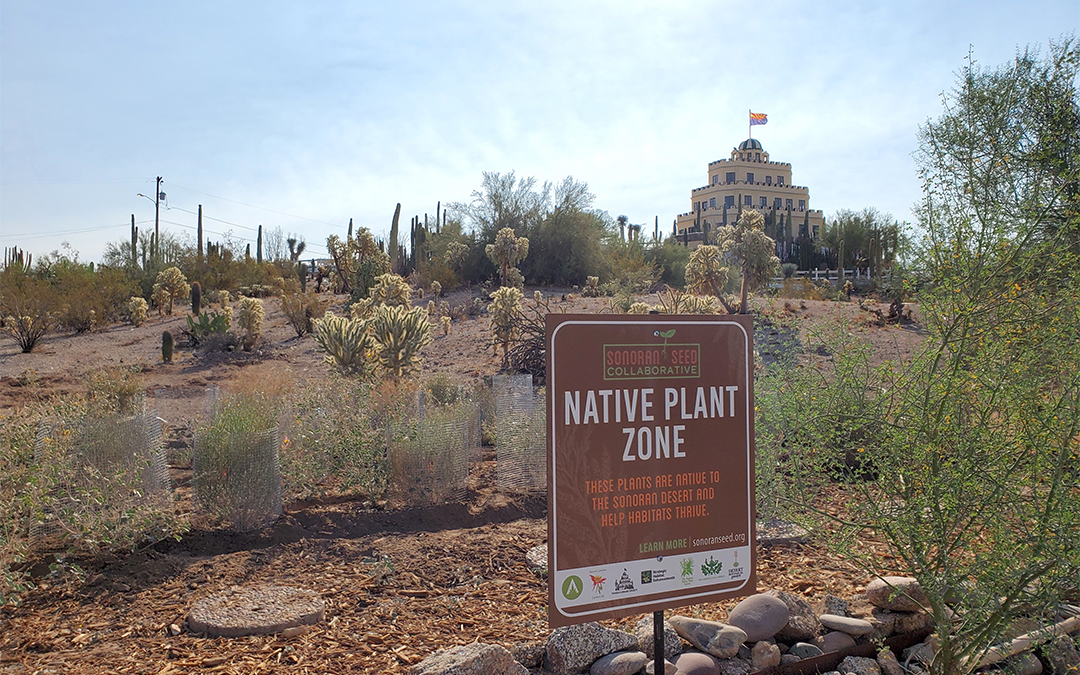In October 2021, Desert Botanical Garden’s Central Arizona Conservation Alliance (CAZCA) initiative started a restoration project at Piestewa Peak that involved dyeing invasive buffelgrass blue, unearthing them with pickaxes and cultivating their replacements at a castle. It’s the first project of the Sonoran Seed Collaborative, a partnership led by CAZCA and dedicated to restoring Maricopa County’s desert parks with locally grown native plant materials.
The Valley’s preserves are threatened by urban development and conflagrations. Wildfires are increasingly raging around the West. Maricopa County is the fastest-growing county in the nation. Development is devouring open spaces, and human activity is spreading invasive plants. Numerous groups are ready to restore damaged wildlands. But they have a problem.
“The challenge that we have regionally is there’s not enough native plant material available for us to do a lot of our restoration work, should a fire occur or even just for degraded lands,” said Annia Quiroz, former engagement coordinator of CAZCA.
Native seeds are typically imported from other states or Pima County, and they’re adapted to their home microclimate, not to the Phoenix area. Several organizations – the Garden/CAZCA, Arizona Columbine Garden Club, Arizona Native Plant Society, Tovrea Carraro Society, Strategic Habitat Enhancements and the city of Phoenix – joined forces to create a local seed-producing strategy.
Several organizations – the Garden, CAZCA, Arizona Columbine Garden Club, Arizona Native Plant Society, Tovrea Carraro Society and the city of Phoenix – joined forces to create a local seed-producing strategy.
“With the Sonoran Seed Collaborative, the plants we’re growing come from Papago Park or North Mountain, which is walking distance from our restoration work at Piestewa Peak,” Aireona Raschke, Ph.D program director of CAZCA, said.
That means the plants are more likely to thrive and foster a healthy ecosystem.
An early collaborator was the Tovrea Carraro Society, which manages Tovrea Castle – a wedding cake-shaped 1928 building listed on the National Register of Historic Places. The Society offered its 44-acre property near Papago Park as a garden for growing pollinator-friendly natives such as sweetbush, desert lavender and desert senna. Volunteers tend the plants and harvest the seeds for distribution at restoration sites.
Piestewa Peak was chosen as the first restoration site because the popular hiking area has been infiltrated by buffelgrass, an invasive species notorious for fueling wildfires. In 2019, Quiroz spearheaded the Buffelgrass Blues campaign to highlight the problem by splashing the buffelgrass with a blue chalky substance and putting up educational signs. Volunteers then uprooted the buffelgrass – a grueling process that requires hours of backbreaking work with pickaxes.
In October 2021, the Sonoran Seed Collaborative spread seeds from around 10 native plants grown at Tovrea Castle.
“It’s important when we take invasive plants out to put something else back so there are resources for the other species, and for us, because people like to see plants on the land,” Raschke said.
The partnership has big plans for the future, including hosting a Seed Summit at the Garden on April 5, 2022.
“We see the Sonoran Seed Collective being a hub where eventually more growers are included, and we can share resources and talk about the challenge of growing native plant materials at a larger scale,” Quiroz said. “The Seed Summit is our first conference that’s focused on having these discussions toward that longer term vision.”


